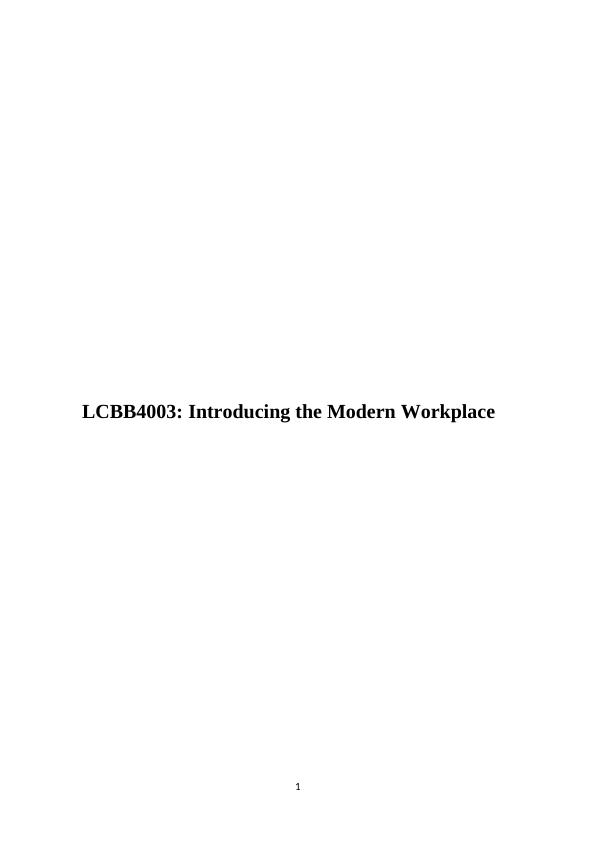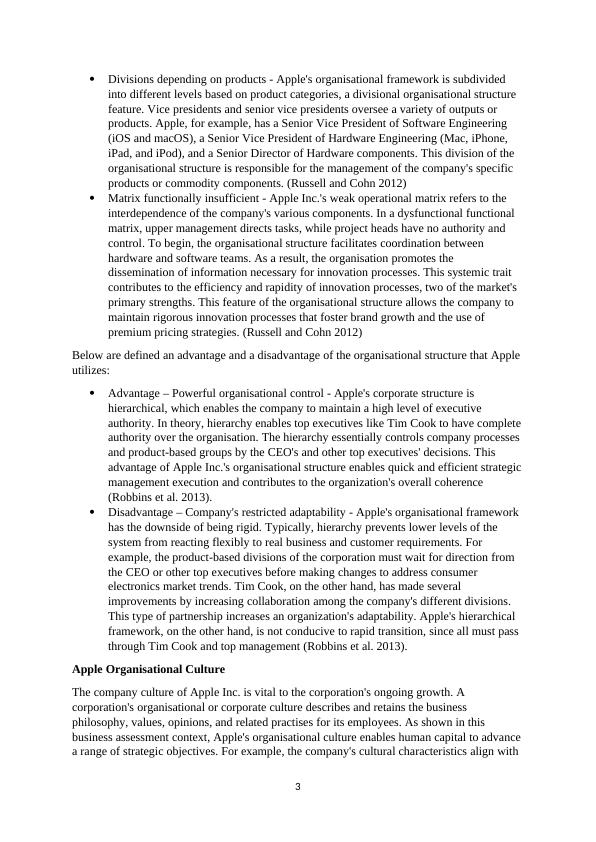LCBB4003: Introducing the Modern Workplace
Added on 2021-06-14
8 Pages3614 Words162 Views
LCBB4003: Introducing the Modern Workplace1

IntroductionThis report involves a rational and academically supported overview of what is beneficial andharmful to Apple Inc.'s organisational structure, culture, performance, and employee behaviour in context of human resource policy and practise. Apple Inc. was founded on April1, 1976 by Steve Jobs, Steve Wozniak, and Ronald Wayne. Afew months after its founding, specifically on the 3rd of January 1977. Apple released itsshares to the public in 1980, a move that catapulted the company to abroadprosperity (Russell and Cohn 2012).LO1Apple Organisational Structure Apple Inc.'s organisational structure allows robust and rapid expansion, which is critical to the company's success in the information technology, online services, and consumer electronics industries. A corporation's organisational or corporate structure is made up of personnel groups, services, and the relationships between these groups and resources. The organisational design serves as a framework for developing and managing the organization's structure. In this business research of Apple Inc., the organisational structure supports policies that foster continued technological advancement. The structural characteristics of the business stick to a traditional hierarchical system while integrating elements from other organisational systems.Apple Inc.'s success is inextricably linked to innovation and Steve Jobs' leadership, and the company's organisational structure helps ensure that leadership is supported. Apple's organisational structure has undergone many small changes under Tim Cook's leadership to meet current multinational industry and sector demands. Apple Inc.'s organisational structure is hierarchical, with distinct divisional characteristics and an inadequate operating matrix. Hierarchy is a hierarchical feature of traditional business organisations. The divisional characteristics refer to the categories of Apple's products, such as iOS and macOS (Jurich 2014). If the hierarchy is preserved, the fragile functional matrix necessitates inter-divisional teamwork. The organisational structure of Apple is described by the following characteristics:Hierarchy with spokes and wheels - Apple's organisational structure is highly hierarchical, as shown from a bird's-eye view. Previously, all passed by Steve Jobs. Jobs are responsible for all significant executive strategy decisions. Nevertheless, under Tim Cook's leadership, Apple's organisational structure has shifted somewhat. The corporation now has a greater level of coordination between its various divisions, such as software and hardware departments. Apple's vice presidents now have a greater degree of control, which was formerly restricted and nominal under Employment. Thus, the hierarchical structure of the enterprise has been less static, butit retains a spoke-and-wheel hierarchy with Tim Cook at the top. The upper tier (innermost tier in the spoke-and-wheel circle) of the corporate structure employs function-based classification, a feature extracted from the functional organisational structure type. Senior vice presidents report to Tim Cook and are responsible for corporate operations. Apple, for example, has an executive vice president in charge ofsales and another in charge of international marketing. Via this strategic aspect, the company's top leaders address consumer demands in terms of market functional departments. (Jurich 2014).2

Divisions depending on products - Apple's organisational framework is subdivided into different levels based on product categories, a divisional organisational structure feature. Vice presidents and senior vice presidents oversee a variety of outputs or products. Apple, for example, has a Senior Vice President of Software Engineering (iOS and macOS), a Senior Vice President of Hardware Engineering (Mac, iPhone, iPad, and iPod), and a Senior Director of Hardware components. This division of the organisational structure is responsible for the management of the company's specific products or commodity components. (Russell and Cohn 2012)Matrix functionally insufficient - Apple Inc.'s weak operational matrix refers to the interdependence of the company's various components. In a dysfunctional functional matrix, upper management directs tasks, while project heads have no authority and control. To begin, the organisational structure facilitates coordination between hardware and software teams. As a result, the organisation promotes the dissemination of information necessary for innovation processes. This systemic trait contributes to the efficiency and rapidity of innovation processes, two of the market's primary strengths. This feature of the organisational structure allows the company to maintain rigorous innovation processes that foster brand growth and the use of premium pricing strategies. (Russell and Cohn 2012)Below are defined an advantage and a disadvantage of the organisational structure that Apple utilizes:Advantage – Powerful organisational control - Apple's corporate structure is hierarchical, which enables the company to maintain a high level of executive authority. In theory, hierarchy enables top executives like Tim Cook to have completeauthority over the organisation. The hierarchy essentially controls company processes and product-based groups by the CEO's and other top executives' decisions. This advantage of Apple Inc.'s organisational structure enables quick and efficient strategicmanagement execution and contributes to the organization's overall coherence (Robbins et al. 2013).Disadvantage – Company's restricted adaptability - Apple's organisational framework has the downside of being rigid. Typically, hierarchy prevents lower levels of the system from reacting flexibly to real business and customer requirements. For example, the product-based divisions of the corporation must wait for direction from the CEO or other top executives before making changes to address consumer electronics market trends. Tim Cook, on the other hand, has made several improvements by increasing collaboration among the company's different divisions. This type of partnership increases an organization's adaptability. Apple's hierarchical framework, on the other hand, is not conducive to rapid transition, since all must pass through Tim Cook and top management (Robbins et al. 2013).Apple Organisational CultureThe company culture of Apple Inc. is vital to the corporation's ongoing growth. A corporation's organisational or corporate culture describes and retains the business philosophy, values, opinions, and related practises for its employees. As shown in this business assessment context, Apple's organisational culture enables human capital to advancea range of strategic objectives. For example, the company's cultural characteristics align with 3

End of preview
Want to access all the pages? Upload your documents or become a member.
Related Documents
Leadership and Management Research Paper 2022lg...
|13
|2785
|28
Analysis of the APPLElg...
|10
|2692
|148
Management People and Teams Project 2022lg...
|5
|1083
|29
management and operations - Assignment PDFlg...
|8
|2449
|45
Organizational Structure of Apple: Factors, Characteristics, and Managementlg...
|10
|2568
|53
Organisational Theory and Practice: A Case Study Analysis of Apple Inc.lg...
|11
|3605
|133
